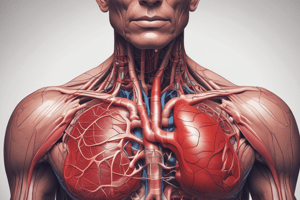Podcast
Questions and Answers
What is the main function of the circulatory system?
What is the main function of the circulatory system?
- Regulating body temperature
- Transporting essential nutrients, oxygen, and hormones to cells and tissues (correct)
- Producing red blood cells
- Removing waste products and carbon dioxide from the body
Which component of the circulatory system forms the systemic circuit?
Which component of the circulatory system forms the systemic circuit?
- Left ventricle (correct)
- Right atrium
- Right ventricle
- Left atrium
What is the composition of blood?
What is the composition of blood?
- Serum, red blood cells, white blood cells, and platelets
- Plasma, red blood cells, green blood cells, and platelets
- Plasma, red blood cells, white blood cells, and platelets (correct)
- Plasma, yellow blood cells, red blood cells, and platelets
Which type of blood vessel carries oxygen-rich blood away from the heart?
Which type of blood vessel carries oxygen-rich blood away from the heart?
What is the function of the pulmonary capillaries in the blood circulation system?
What is the function of the pulmonary capillaries in the blood circulation system?
During which phase of the heart's pumping cycle does the ejection period occur?
During which phase of the heart's pumping cycle does the ejection period occur?
In which circulation does the oxygen-rich blood travel from the left atrium via the aorta to the rest of the body?
In which circulation does the oxygen-rich blood travel from the left atrium via the aorta to the rest of the body?
Where do the arteries deliver oxygen-rich blood in the coronary circulation?
Where do the arteries deliver oxygen-rich blood in the coronary circulation?
What is the main function of the circulatory system in maintaining health and well-being?
What is the main function of the circulatory system in maintaining health and well-being?
After oxygen and nutrients are exchanged in the capillaries, what type of blood returns to the veins?
After oxygen and nutrients are exchanged in the capillaries, what type of blood returns to the veins?
Flashcards are hidden until you start studying
Study Notes
Exploring the Biology of the Circulatory System
The circulatory system, also referred to as the cardiovascular system, is a vital component of life for multicellular organisms. This intricate network serves to transport essential nutrients, oxygen, and hormones to cells and tissues, whilst removing waste products and carbon dioxide to maintain overall health and well-being.
Major Components of the Circulatory System
The Heart: The heart, a muscular organ, is responsible for pumping blood throughout the body. It is divided into four chambers: two atria (upper chambers) and two ventricles (lower chambers). The right atrium and right ventricle make up the pulmonary circuit, sending blood to the lungs, while the left atrium and left ventricle form the systemic circuit, sending blood to the rest of the body.
Blood: Blood is a fluid composed of plasma (91% water), proteins, cells, and gases. It consists of three main types: plasma, red blood cells (erythrocytes), white blood cells (leukocytes), and platelets (thrombocytes).
Blood Vessels: Blood vessels form an elaborate network to transport blood. They include arteries (which carry oxygen-rich blood away from the heart), veins (which transport oxygen-poor blood toward the heart), and capillaries (tiny vessels that allow nutrient exchange between the blood and cells).
The Circulatory System's Main Functions
The circulatory system has two major functions: the pulmonary circulation and the systemic circulation.
Pulmonary Circulation: This short circuit begins at the right ventricle, which pumps blood to the lungs via the pulmonary arteries. In the lungs, the blood receives oxygen and releases carbon dioxide through the pulmonary capillaries. The blood then returns to the left atrium via the pulmonary veins.
Systemic Circulation: The left ventricle pumps oxygen-rich blood from the left atrium via the aorta to the rest of the body. Oxygen is delivered to tissues, nutrients are absorbed, and carbon dioxide is picked up for removal. Blood containing carbon dioxide returns to the right atrium via the venous system.
Coronary Circulation: This circuit serves the heart itself. Arteries deliver oxygen-rich blood to the heart while veins transport oxygen-poor blood back to the right atrium.
Blood Circulation in the Body
Blood circulation starts when the heart relaxes between two heartbeats. The atria fill with blood, and when they contract, they push the blood into the ventricles. The ventricles contract, and the blood is forced into the arteries. This process is known as the ejection period.
Blood then travels from the main arteries to smaller arteries, arterioles, and capillaries. Oxygen and nutrients are exchanged in the capillaries, and waste products are picked up. The blood then returns to the veins as oxygen-poor blood, which is transported back to the heart.
The circulatory system maintains our health and well-being by ensuring that cells, tissues, and organs receive adequate oxygen and nutrients while removing waste products. The system works in conjunction with other body systems, such as the respiratory and metabolic systems, to support a healthy and functional organism.
Studying That Suits You
Use AI to generate personalized quizzes and flashcards to suit your learning preferences.




